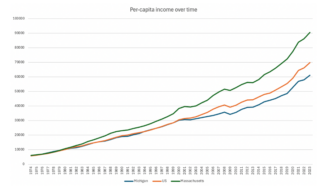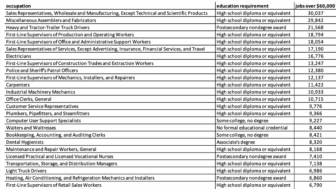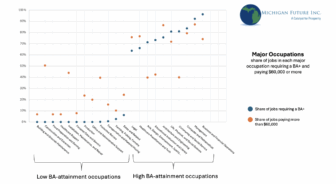The new ![]() Michigan Association of United Ways ALICE report (for Asset Limited, Income Constrained, Employed), makes clear that Michigan is facing severe structural economic challenges. In the seventh year of a national economic expansion––and an even stronger rebound from near bankruptcy of the domestic auto industry––too many Michigan households are struggling.
Michigan Association of United Ways ALICE report (for Asset Limited, Income Constrained, Employed), makes clear that Michigan is facing severe structural economic challenges. In the seventh year of a national economic expansion––and an even stronger rebound from near bankruptcy of the domestic auto industry––too many Michigan households are struggling.
Forty percent of Michigan households do not have sufficient income to pay for the necessities: primarily housing, childcare, food, health care, taxes and transportation. More than 1.5 million Michigan households are without adequate income to pay for basic necessities. As the report makes clear this is an all Michigan problem: in every county, among all races and all ages.
More broadly our challenges in Michigan are similar to those Robert Putnam documented in his book, Our Kids: that the top quarter of American households are doing well and the other three quarters are struggling to keep up, many falling farther and farther behind. On measure after measure of economic and social well-being of households and their children Putnam presents charts that look like open scissors with those in the top quartile advancing and those in the bottom three quarters declining.
This pattern is true irrespective of race. Racial discrimination is an ongoing reality in employment, education, housing and the criminal justice system; but class is now the main dividing line in the American economy and increasingly class is defined by college attainment.
The preeminent challenge of our times is figuring out how to reverse what is being called the Great Decoupling. Where even when the economy is growing––as it has been in Michigan since the end of the Great Recession––only those at the top are benefiting from that growth. The policy priority needs to be reestablishing an economy where as the economy grows all Michigan households enjoy rising incomes.
It should now be clear that having a growing economy, or a low unemployment rate, or being business friendly––all of which have been the goals of state policymakers now and in the past––does not lead to an economy that benefits all. Michigan has been making progress on all three since the end of the Great Recession. Its far past time that we make explicit that the goal of state economic policy is a rising household income for all Michiganders.
About half of today’s jobs in Michigan are not high skill. And therefore are not high paid. That is the fundamental shift that has occurred in our economy over the past several decades. And the prime cause for so many ALICE households. The high-paid, low-education-attainment jobs that were the backbone of Michigan’s mass 20th Century middle class are gone forever.
In their book the Second Machine Age Erik Brynjolfsson and Andrew McAfee project that in an age of brilliant technologies economic growth will accelerate substantially but the distribution of economic gains will concentrate even more than today at the top. So there is little reason to believe going forward that there will be a higher proportion of good-paying jobs.
The ALICE data––the sheer scale of those in economic stress––should make clear to all that the prime cause for so many households struggling to make end meet is not people unwilling to do what is necessary to obtain available family-supporting work, but rather that the economy is not producing enough family-supporting jobs.
Nor is it that we have a too generous safety net that discouraged people from working. As we documented in our State Policies Matters report Minnesota has a far more generous safety net than Michigan. And it is third in the proportion of those 16 and older working, Michigan is 40th. If the same proportion of Michiganders age 16 and above worked as Minnesotans there would be 830,000 more Michiganders working today.
Michigan cannot substantially reduce the proportion of households that cannot pay for basic necessities unless it finds ways to increase the amount of work and the pay and benefits of that work for those with low education attainment. That means a public policy that makes a priority of tackling the multiple barriers to work that households face: housing, childcare, transportation, substance abuse, physical and mental heath in addition to job training. And public policy designed to raise the returns from work through some combination of employer mandates and/or a strengthened safety net. To achieve the goal of getting all Michiganders on the path to good-paying careers income and benefits from work will need to be augmented for many.
But by far the most reliable path to substantially reducing the number of Michigan ALICE households is increased education attainment. The data are clear: the higher one’s education attainment the more one works and earns. The power of education attainment in raising one’s income has been growing for decades. The odds are great that the income gap by education attainment will continue to widen. The most reliable path to a good-paying career is with a bachelor’s degree or more, in both STEM and non-STEM fields.
Clearly not all good-paying jobs require a four-year degree. There are many good-paying jobs that can be obtained with an associate’s degree or occupational credential. But the preponderance of good-paying jobs are going to those with four-year degrees or more.
In addition, the labor market is now characterized by accelerated creative destruction. Those who have the agility and ability to constantly switch occupations will do best over a forty year career. The notion of a career ladder––predictable and linear steps upward––in a world that is constantly changing is obsolete.
Rather people will need to be like rock climbers––constantly adjusting to new opportunities and challenges, and then resourceful to take advantage of those opportunities. Add to that, in an economy where more and more work is contingent, increasingly the ability to be your own employer. Finding good-paying work and good benefits and managing your own finances. These are the kind of skills that are developed best by earning a four-year degree, particularly in the liberal arts.
If Michigan is going to be a place with a broad middle class, if employers are going to have the supply of skilled workers they need and if Michigan is going to be a place once again where kids regularly do better than their parents, it will happen because the state made a commitment to provide an education system for all from birth through higher education that builds rigorous broad skills that are the foundation of successful forty-year careers.







